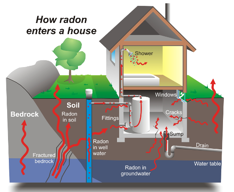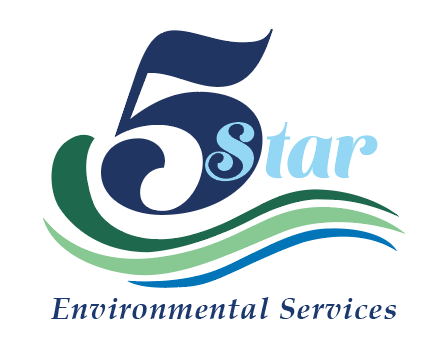Radon Testing
 Radon is a radioactive gas that can be present in any type building, including homes, offices, schools and hi-rise buildings and has been recorded all over the World. You cannot see, smell or taste RADON. Radon is a radio active gas that comes from the natural (radioactive) breakdown of uranium in soil, rock, water and air that we all breathe. Radon typically moves up through the soil to the air above and into our homes through cracks and other holes in the foundation. Radon can even enter a structure through well water. Most structures can trap radon inside. Structures on a slab, crawlspace or basement type foundations could have a major radon issue. In fact, families are most likely to get the greatest radon exposure at home, since usually this is where most families spent their time. A radon problem can be corrected with a mitigation system (depressurization technique) which can reduce high levels of radioactive gas to acceptable levels.
Radon is a radioactive gas that can be present in any type building, including homes, offices, schools and hi-rise buildings and has been recorded all over the World. You cannot see, smell or taste RADON. Radon is a radio active gas that comes from the natural (radioactive) breakdown of uranium in soil, rock, water and air that we all breathe. Radon typically moves up through the soil to the air above and into our homes through cracks and other holes in the foundation. Radon can even enter a structure through well water. Most structures can trap radon inside. Structures on a slab, crawlspace or basement type foundations could have a major radon issue. In fact, families are most likely to get the greatest radon exposure at home, since usually this is where most families spent their time. A radon problem can be corrected with a mitigation system (depressurization technique) which can reduce high levels of radioactive gas to acceptable levels.
Exposure to RADON can cause health issues – Radon is considered a Class A Carcinogen that can cause cancer. The Surgeon General has warned that radon is the second leading cause of lung cancer in the United States and breathing it over prolonged periods can present a significant health risk to families all over the country. It’s important to know that this threat is completely preventable. Only smoking causes more lung cancer deaths. Radon gas decays into polonium particulates referred to as radon progeny or radon decay products that can get trapped in your lungs when you breathe. As they break down further, these particles release high impacting alpha particles. These alpha particles can damage lung tissue and lead to lung cancer over a period of time of exposure. Not everyone exposed to elevated levels of radon decay products will develop lung cancer. The amount of time between exposure and the onset of the disease may or may not be many years.
5 Star Environmental Services Certified Radon Technician, Shannon Cory (Certification #102549RT) can answer any of your questions in reference to this deadly carcinogen. When a radon test is performed at your location, state-of-the-art electronic monitor is used for accurate and quick results. The monitor needs to be placed in the lowest level of the structure that could be used regularly, whether it is finished or unfinished. The monitors that are used take a reading every hour for 48 hours or more and then the data is analyzed and a report is issued showing the average results. Note – EPA “Home Buyer’s and Seller’s Guide to Radon” indicates that any level of radon gas above 2.0 pCi/L still poses a risk of lung cancer. (visit – epa.gov/radon for more information).
To schedule a radon test or to have any questions answered just call – 404-316-4876
